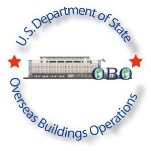Located within the US Department of State, the Bureau of Overseas Buildings Operations (OBO) is responsible for the buildings that house America’s overseas embassies, consulates and missions. OBO conducts much of its work using domestic contractors who handle the building of new embassies. Since the 1998 bombings of American embassies in east Africa, the federal government has conducted the largest construction effort in US diplomatic history to upgrade diplomatic posts and secure them against terrorist attacks. Problems have arisen, however, in the course of several high-profile embassy projects, including the sprawling new complex in Baghdad, Iraq.
Standard Embassy Design Document
(PDF)
- Allowance for future expansion on the site, reserving space for additional facilities such as a large office annex, small office annex, warehouse and additional parking.
- Allowance for future expansion of the office building.
- Established areas for official, staff and visitor vehicle parking.
- Established building mass - two office blocks flanking a central atrium.
- Established building entrances and locations of core elements.
- Established minimum permissible baseline standards for building materials as well as interior finishes.
- Consideration of high temperatures, humidity, dust, rain and salinity of air when designing and selecting mechanical equipment.
OBO’s New Embassy Compound Process (PDF)
Doing Business with the Bureau of Overseas Building Operations (by Guy Timblerlake, Washington Technology)
Evaluation and Analysis of Cost/Schedule Data Kabul Embassy Compound Project
(OIG) (PDF)
- Table of Contents
- Overview
- History
- What it Does
- Where Does the Money Go
- Controversies
- Suggested Reforms
- Comments
- Leave a comment


Lydia J. Muniz served at the U.S. Department of State as director of the Bureau of Overseas Buildings Operations (OBO) from June 19, 2012 to January 20, 2017, the day that Donald Trump was inaugurated as president of the United States. OBO directs the worldwide overseas building program for the State Department and serves as the property manager for the government’s diplomatic properties overseas.
A graduate of the University of California at Berkeley, Muniz also earned a Masters degree in International Affairs from Columbia University, School of International and Public Affairs, with a concentration in Economic and Political Development.
Muniz worked as office manager for Leon E. Panetta (D-California) in the House of Representatives. In 1995, she was legislative assistant in the Office of Legislative Affairs of the Office of Management and Budget and in 1996 she was special assistant for policy in the Office of the Secretary of the Army. She then served as deputy director of the Department of Media Affairs in the Organization for Security and Cooperation in Europe Mission to Bosnia and Herzegovina.
Muniz held several positions at New York University from 2001 to 2009. Her last job there was as associate vice president in the Office of Strategic International and Business Projects, advising the university on the development of international branch campuses. She had also been associate vice president for the Division of Campus Planning, Design and Real Estate, working on capital planning, space planning, design and real estate planning, acquisition and sales.
Prior to her appointment as director of OBO, Muniz served the Bureau as principal deputy director.
In 2007, Muniz married architect Robert Young. The couple have one daughter, Margot.
-Matt Bewig
To Learn More:
Report Details Enduring Flaws in State Dept. Diplomatic Security (by Edward T. Pound, Al Jazeera)

President Barack Obama has turned to an experienced Latin America hand, Adam E. Namm, to serve as the new ambassador to Ecuador, replacing former ambassador Heather Hodges, who in April 2011 was expelled by the Ecuadorian government after the release by WikiLeaks of a diplomatic cable in which Hodges discussed allegedly corrupt police officials appointed to positions of high command by President Rafael Correa, and even speculated that Correa “must have known” about the corruption.
- Latest News
- D.C. Public Schools will Teach all Second-Graders to Ride a Bike
- New Rule in Germany Limits Sales of Sex-Themed E-Books to 10pm to 6am
- What Happened to the 6-Year-Old Tibetan Boy the Chinese Government Kidnapped 20 Years Ago?
- U.S. Ambassador to Turkey Photoshops his Hair Color to Mock Turkish Mayor
- Mystery Artist Calls Attention to Unfixed Potholes by Drawing Penises around Them
Located within the US Department of State, the Bureau of Overseas Buildings Operations (OBO) is responsible for the buildings that house America’s overseas embassies, consulates and missions. OBO conducts much of its work using domestic contractors who handle the building of new embassies. Since the 1998 bombings of American embassies in east Africa, the federal government has conducted the largest construction effort in US diplomatic history to upgrade diplomatic posts and secure them against terrorist attacks. Problems have arisen, however, in the course of several high-profile embassy projects, including the sprawling new complex in Baghdad, Iraq.
Standard Embassy Design Document
(PDF)
- Allowance for future expansion on the site, reserving space for additional facilities such as a large office annex, small office annex, warehouse and additional parking.
- Allowance for future expansion of the office building.
- Established areas for official, staff and visitor vehicle parking.
- Established building mass - two office blocks flanking a central atrium.
- Established building entrances and locations of core elements.
- Established minimum permissible baseline standards for building materials as well as interior finishes.
- Consideration of high temperatures, humidity, dust, rain and salinity of air when designing and selecting mechanical equipment.
OBO’s New Embassy Compound Process (PDF)
Doing Business with the Bureau of Overseas Building Operations (by Guy Timblerlake, Washington Technology)
Evaluation and Analysis of Cost/Schedule Data Kabul Embassy Compound Project
(OIG) (PDF)
Comments


Lydia J. Muniz served at the U.S. Department of State as director of the Bureau of Overseas Buildings Operations (OBO) from June 19, 2012 to January 20, 2017, the day that Donald Trump was inaugurated as president of the United States. OBO directs the worldwide overseas building program for the State Department and serves as the property manager for the government’s diplomatic properties overseas.
A graduate of the University of California at Berkeley, Muniz also earned a Masters degree in International Affairs from Columbia University, School of International and Public Affairs, with a concentration in Economic and Political Development.
Muniz worked as office manager for Leon E. Panetta (D-California) in the House of Representatives. In 1995, she was legislative assistant in the Office of Legislative Affairs of the Office of Management and Budget and in 1996 she was special assistant for policy in the Office of the Secretary of the Army. She then served as deputy director of the Department of Media Affairs in the Organization for Security and Cooperation in Europe Mission to Bosnia and Herzegovina.
Muniz held several positions at New York University from 2001 to 2009. Her last job there was as associate vice president in the Office of Strategic International and Business Projects, advising the university on the development of international branch campuses. She had also been associate vice president for the Division of Campus Planning, Design and Real Estate, working on capital planning, space planning, design and real estate planning, acquisition and sales.
Prior to her appointment as director of OBO, Muniz served the Bureau as principal deputy director.
In 2007, Muniz married architect Robert Young. The couple have one daughter, Margot.
-Matt Bewig
To Learn More:
Report Details Enduring Flaws in State Dept. Diplomatic Security (by Edward T. Pound, Al Jazeera)

President Barack Obama has turned to an experienced Latin America hand, Adam E. Namm, to serve as the new ambassador to Ecuador, replacing former ambassador Heather Hodges, who in April 2011 was expelled by the Ecuadorian government after the release by WikiLeaks of a diplomatic cable in which Hodges discussed allegedly corrupt police officials appointed to positions of high command by President Rafael Correa, and even speculated that Correa “must have known” about the corruption.
- Latest News
- D.C. Public Schools will Teach all Second-Graders to Ride a Bike
- New Rule in Germany Limits Sales of Sex-Themed E-Books to 10pm to 6am
- What Happened to the 6-Year-Old Tibetan Boy the Chinese Government Kidnapped 20 Years Ago?
- U.S. Ambassador to Turkey Photoshops his Hair Color to Mock Turkish Mayor
- Mystery Artist Calls Attention to Unfixed Potholes by Drawing Penises around Them





Comments